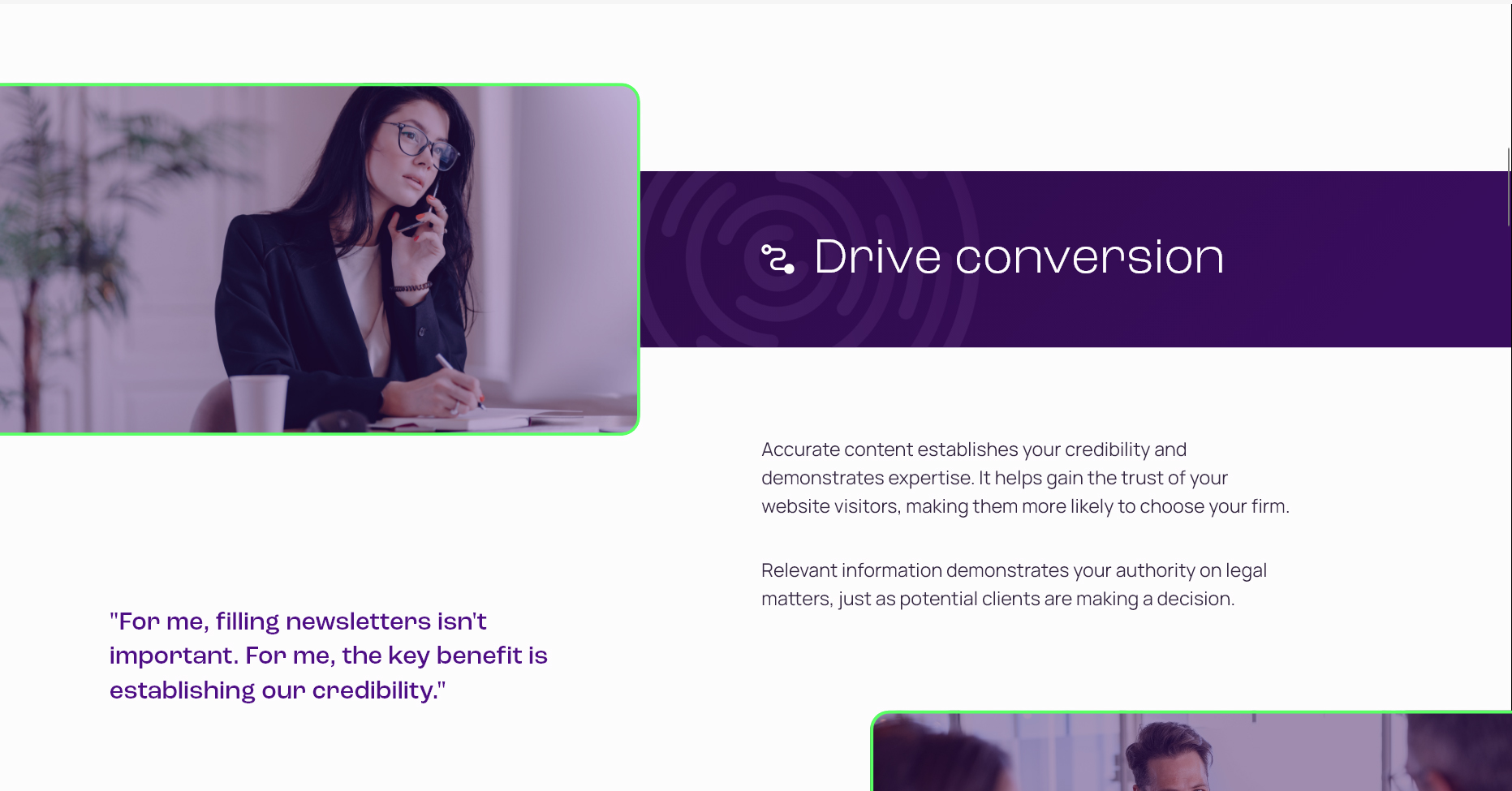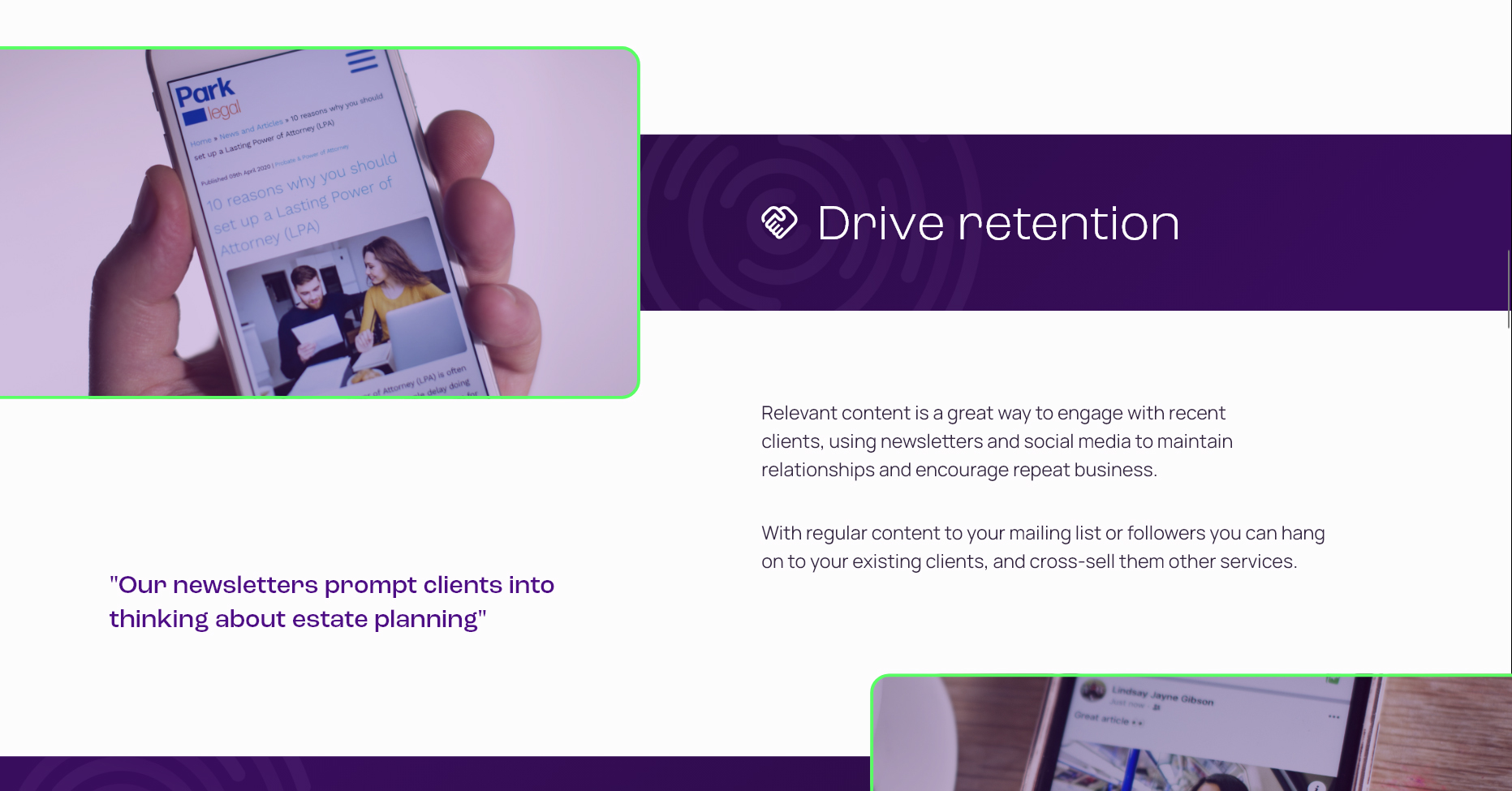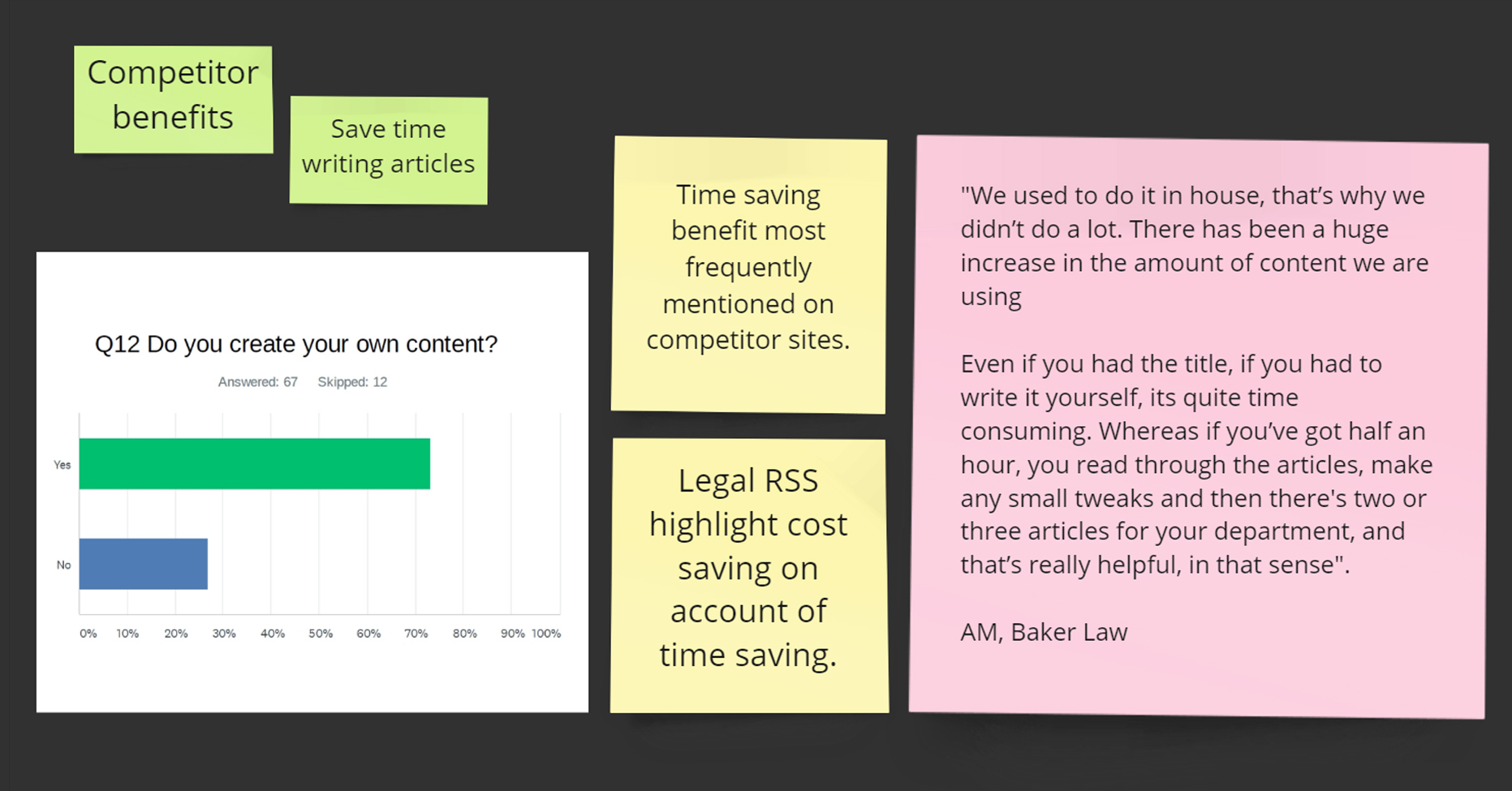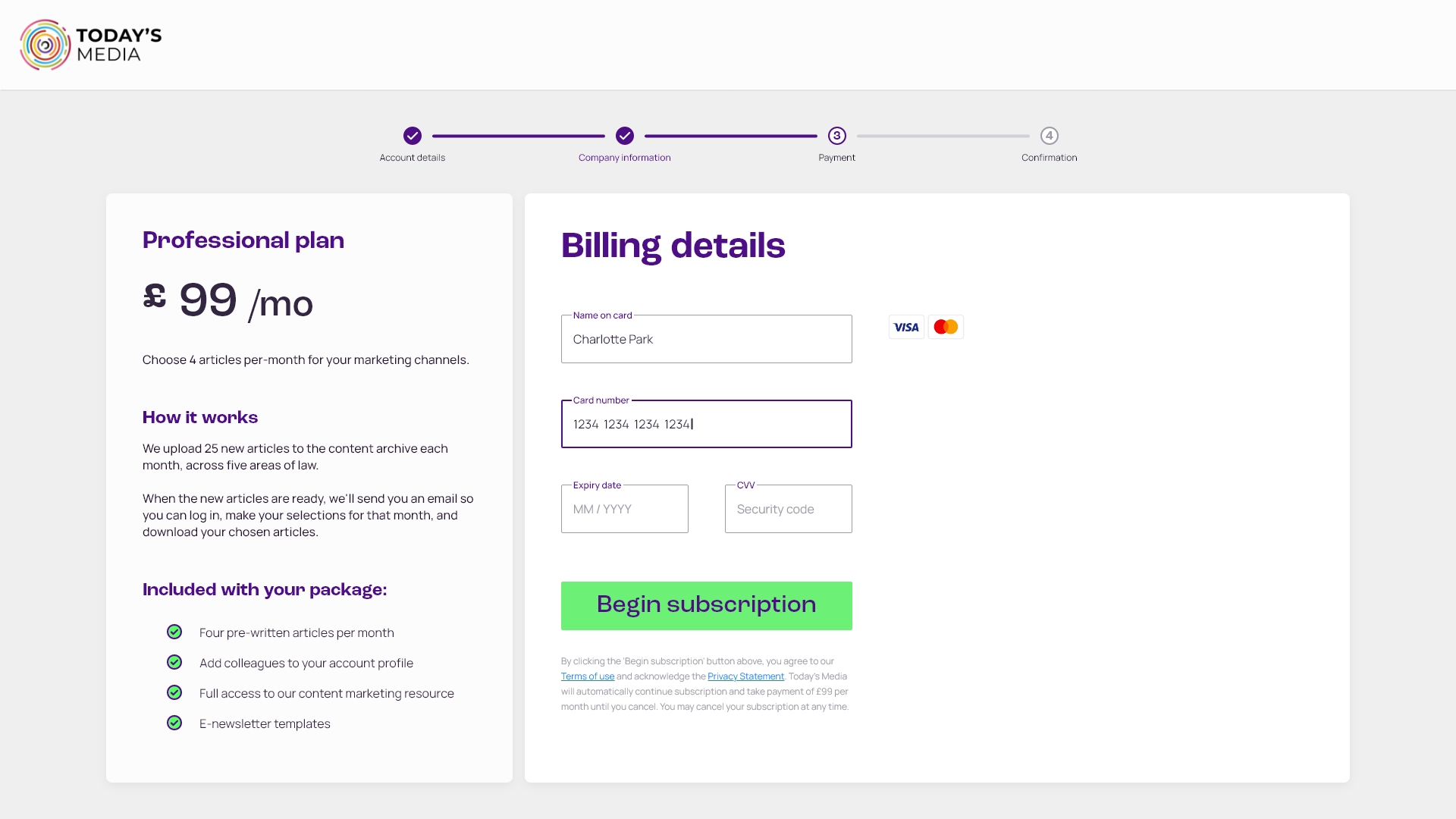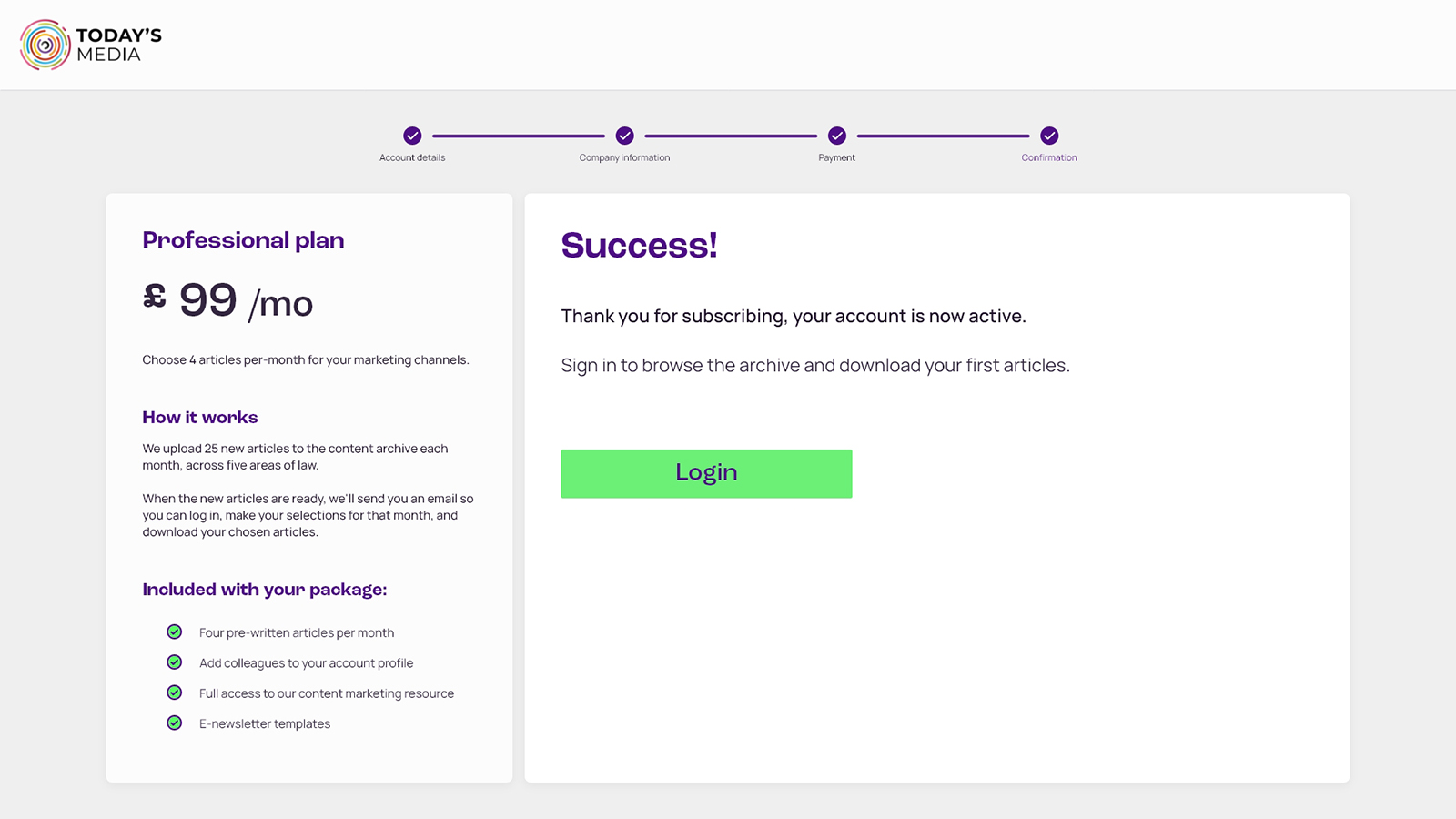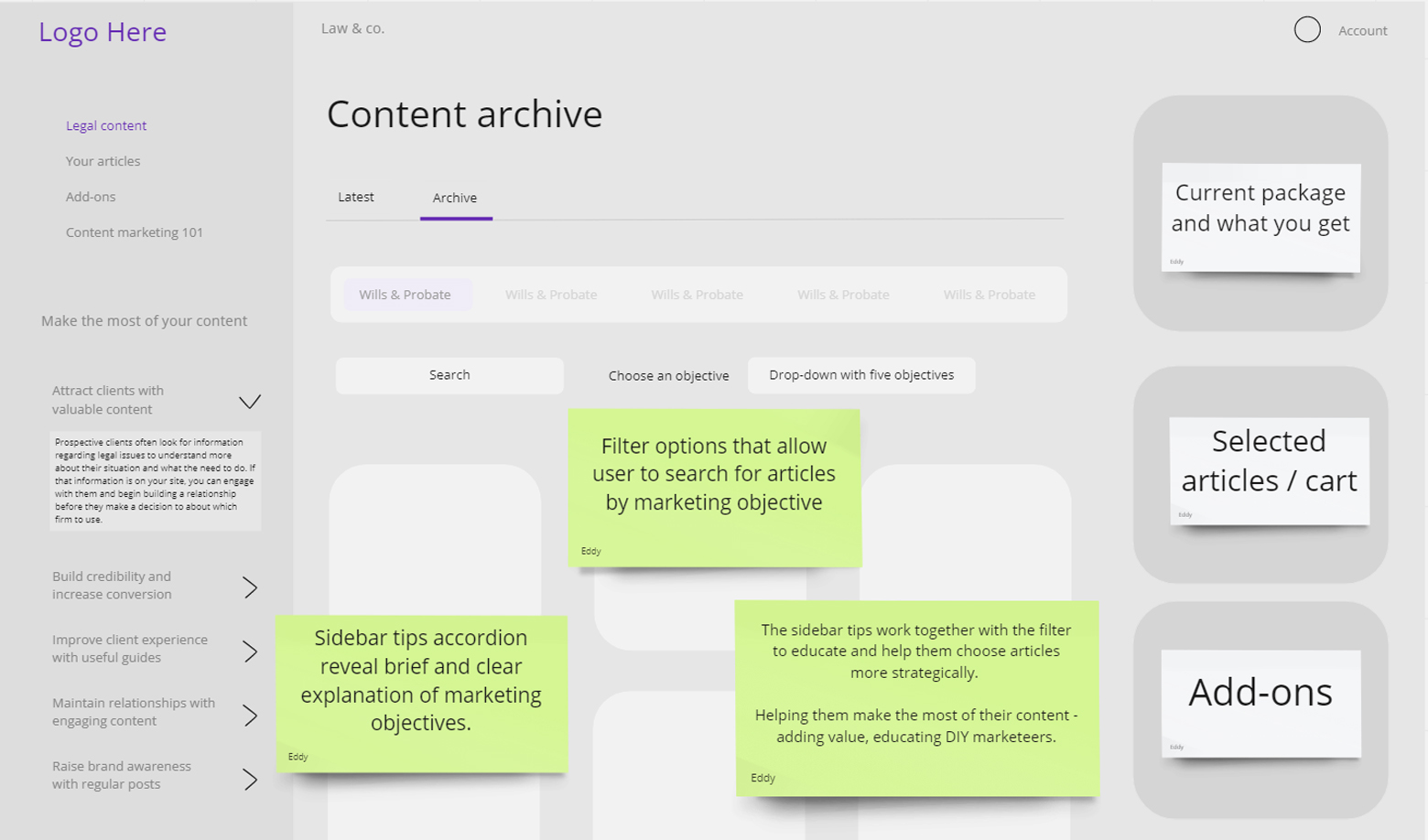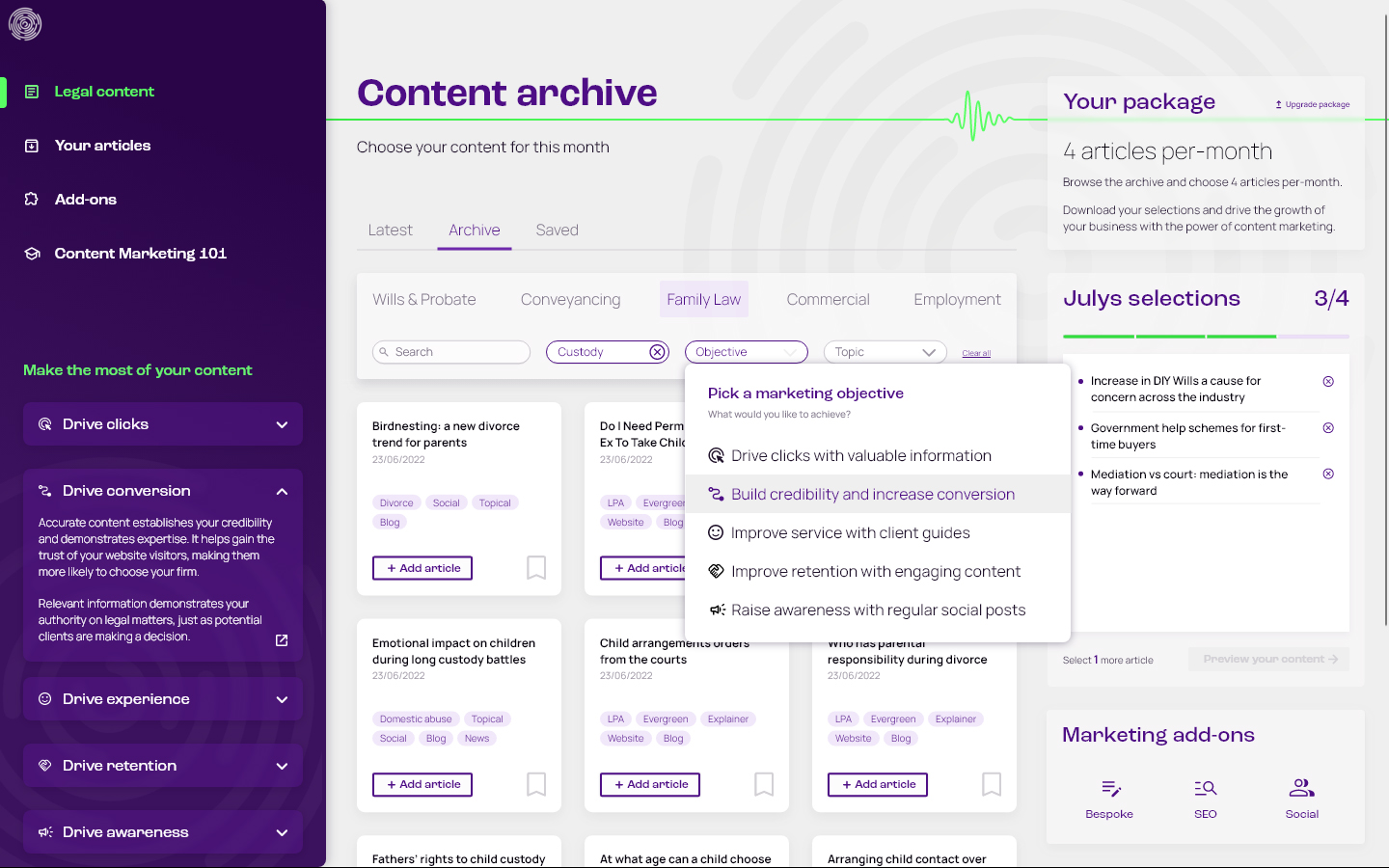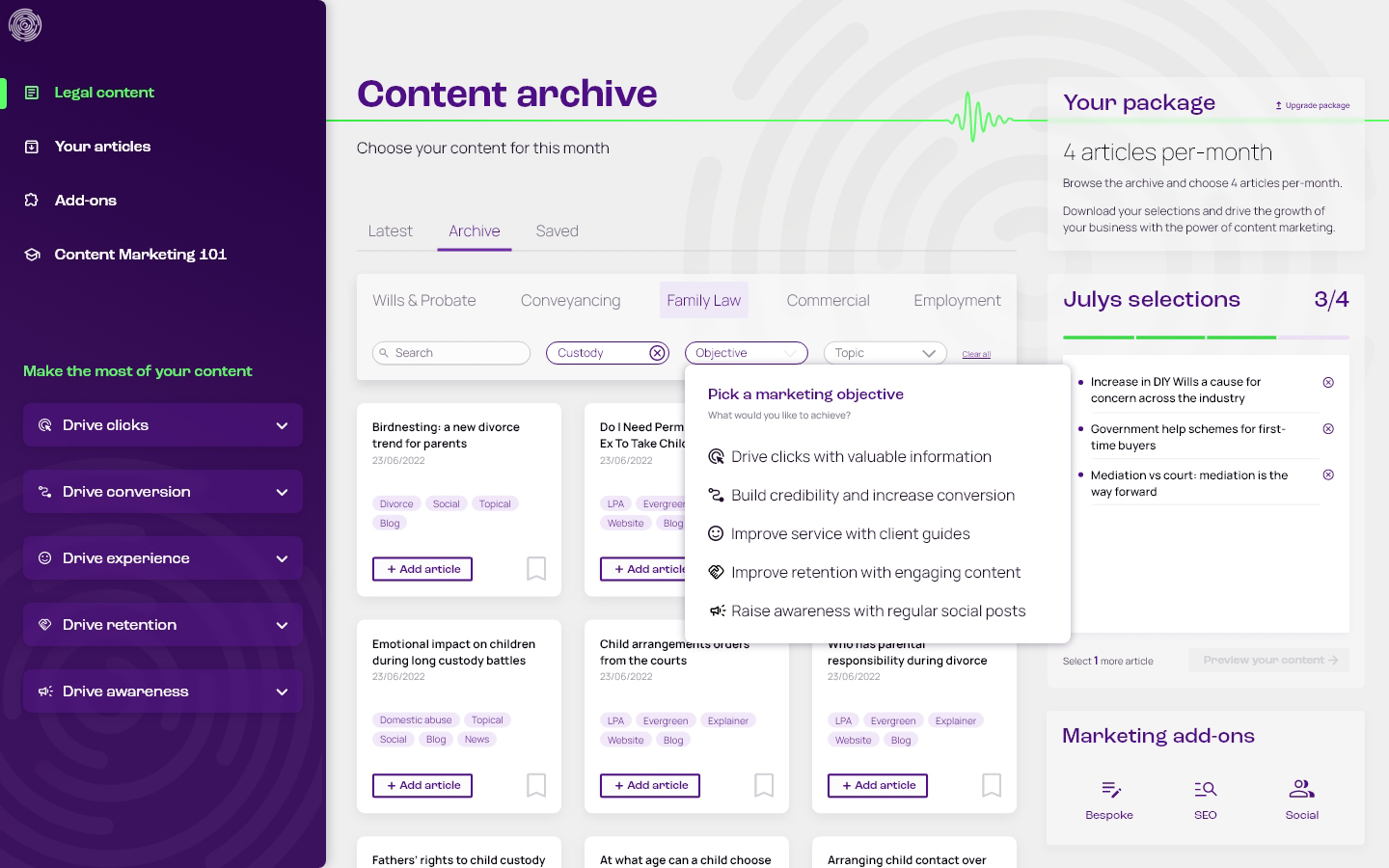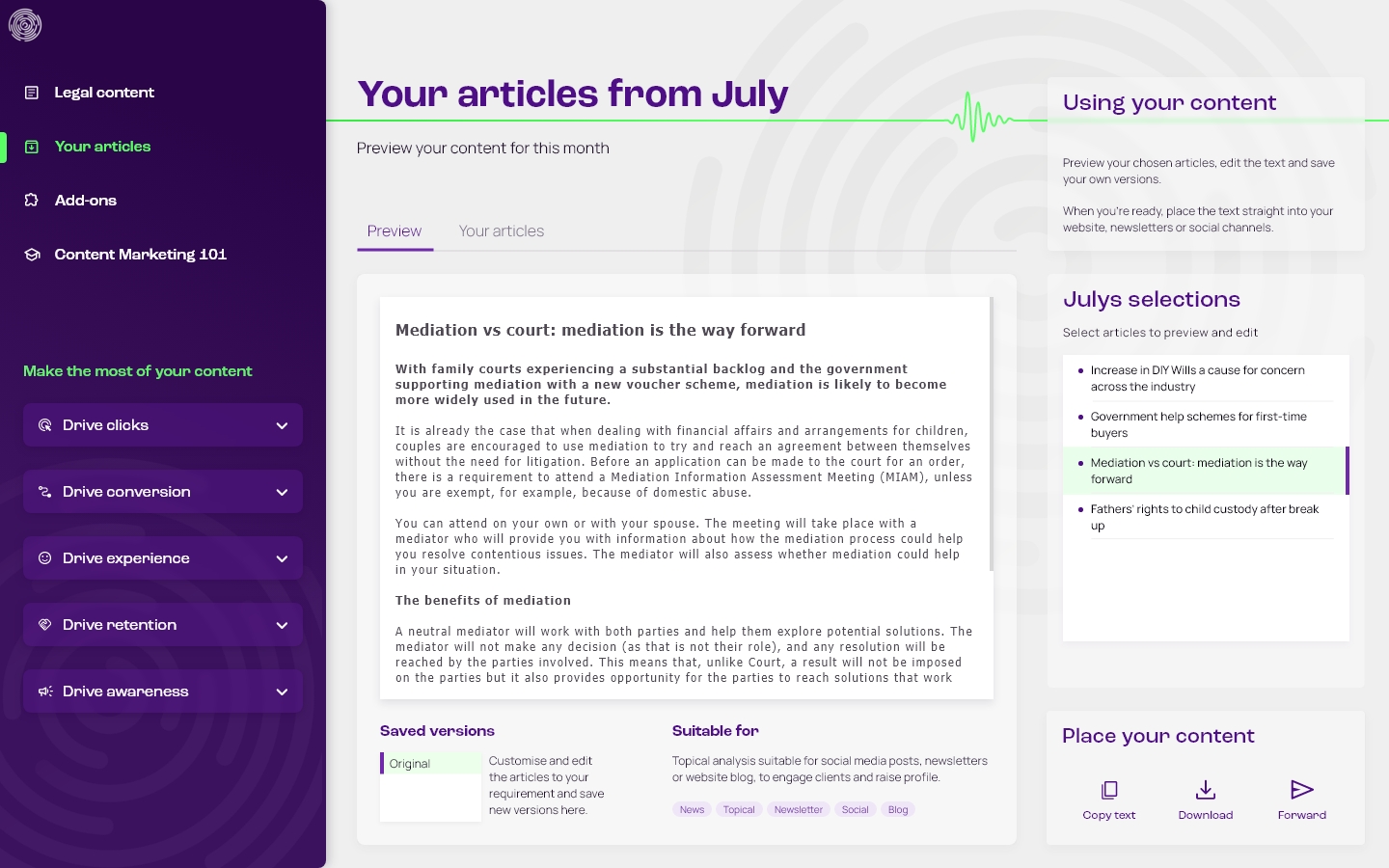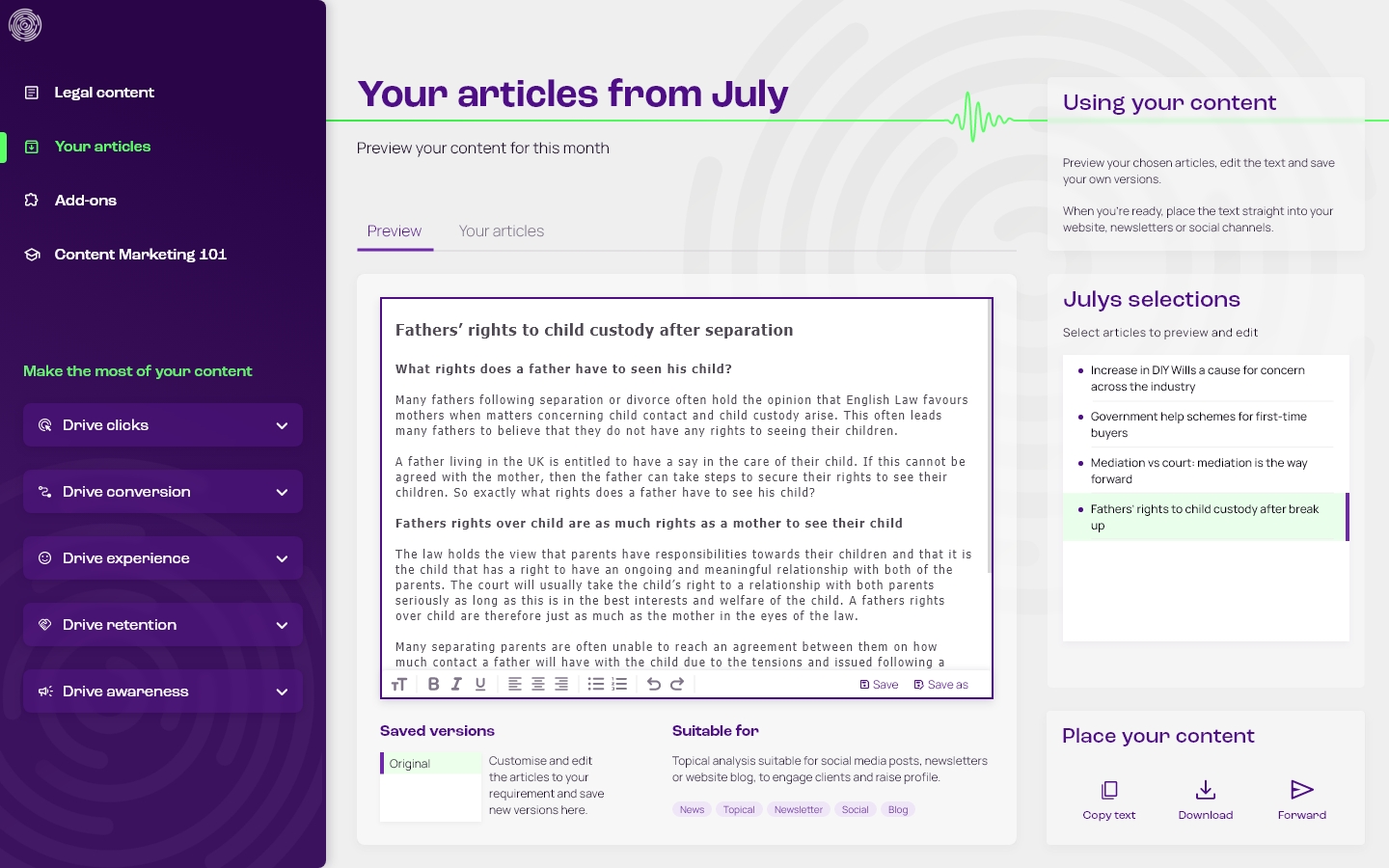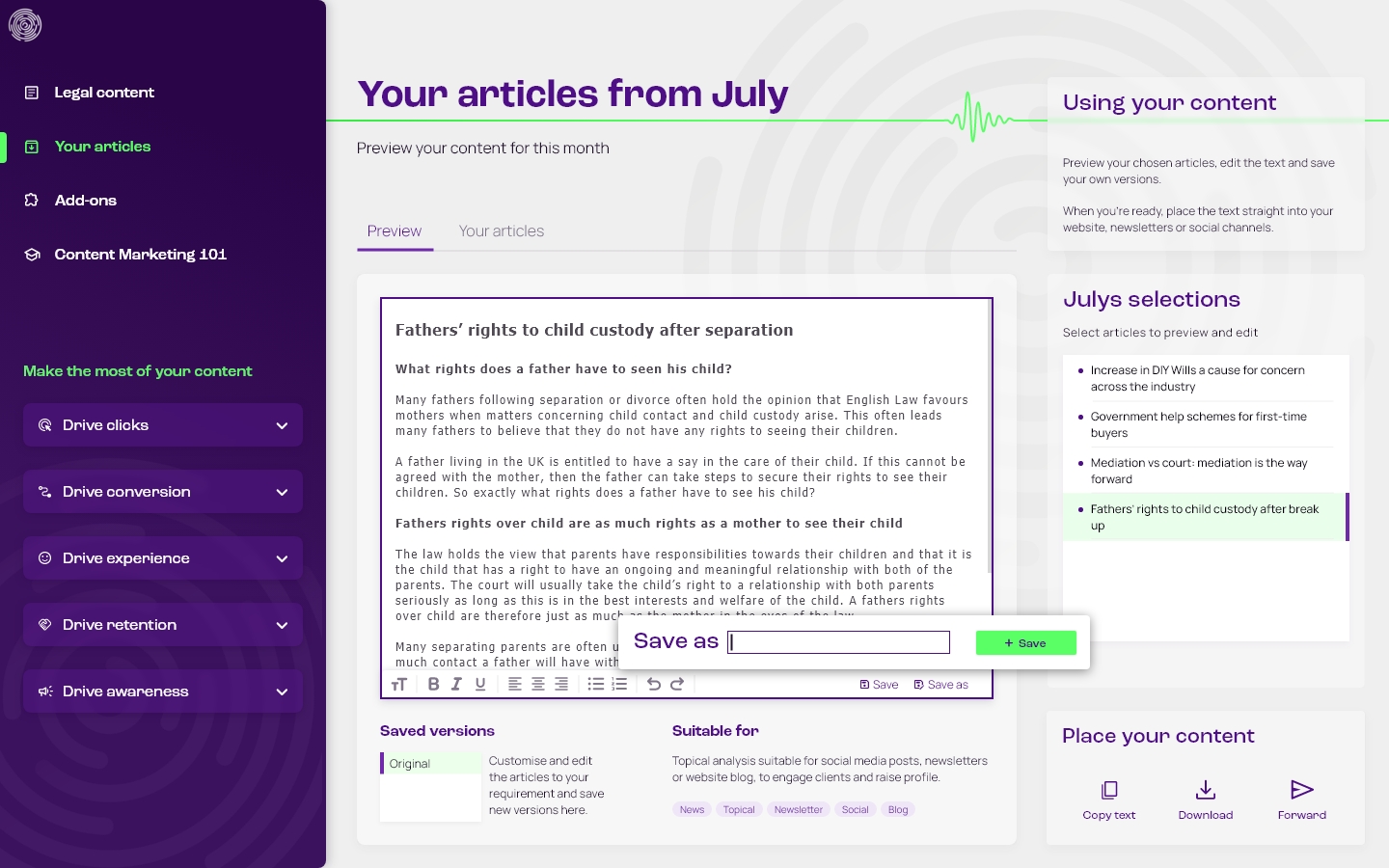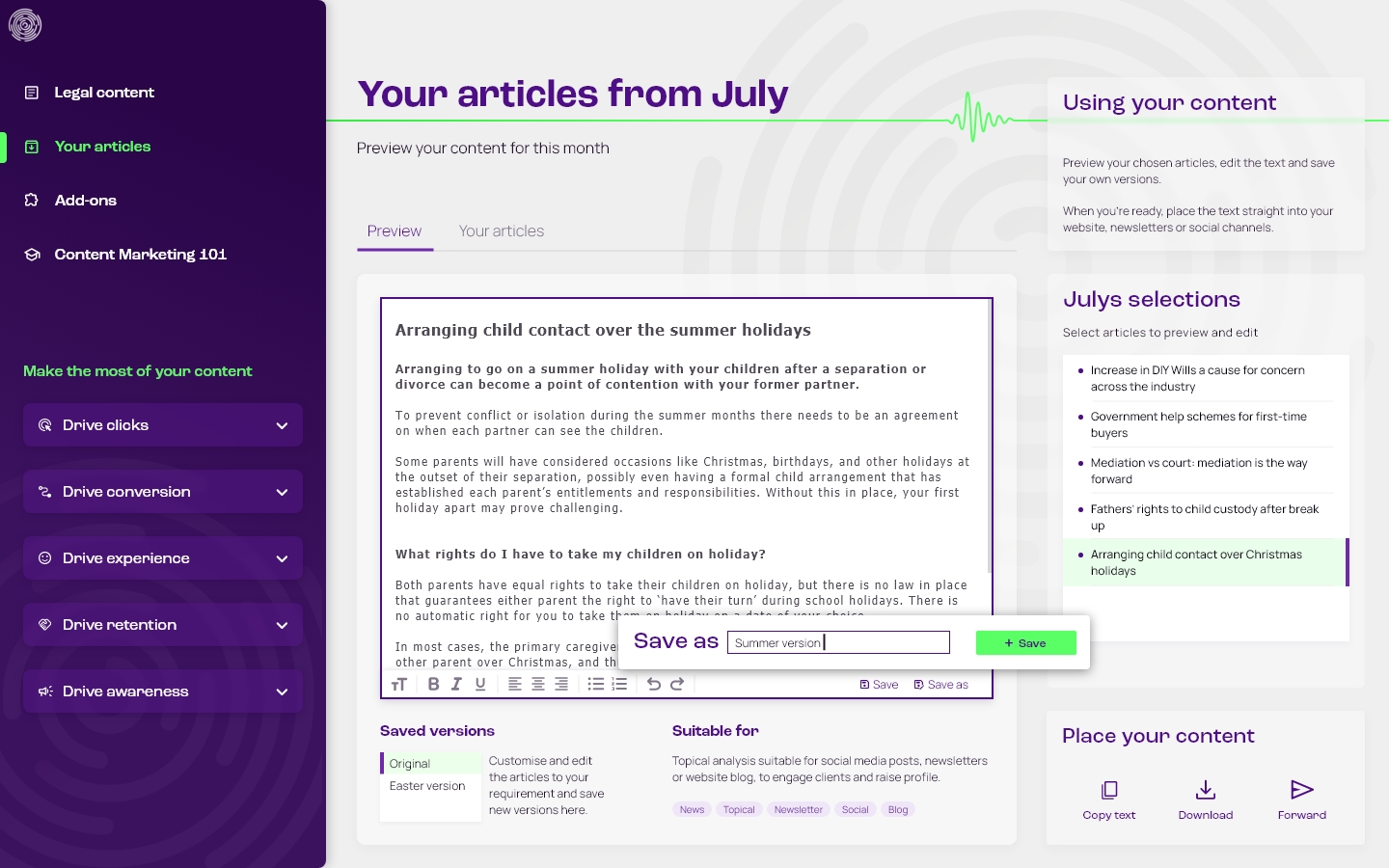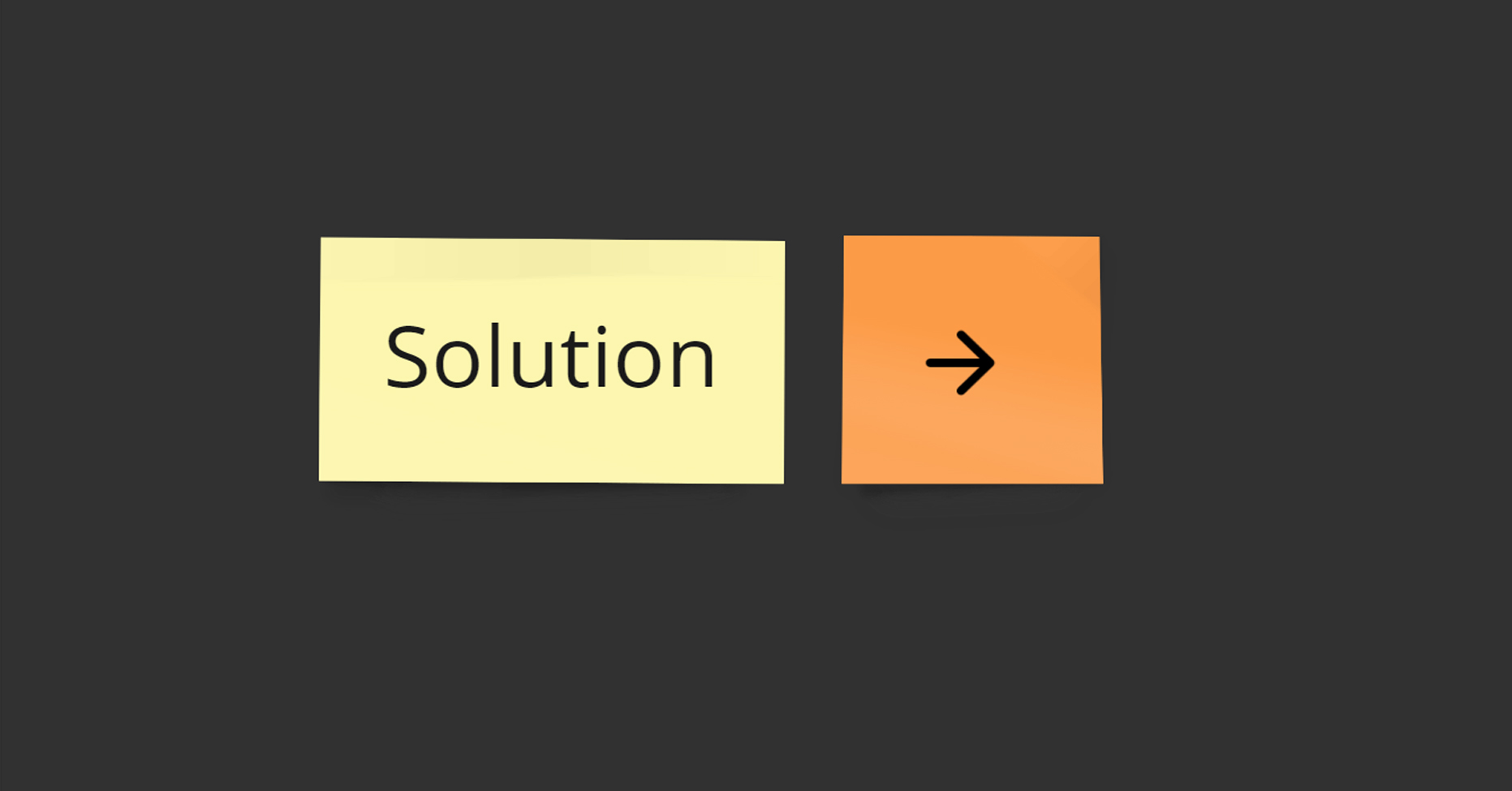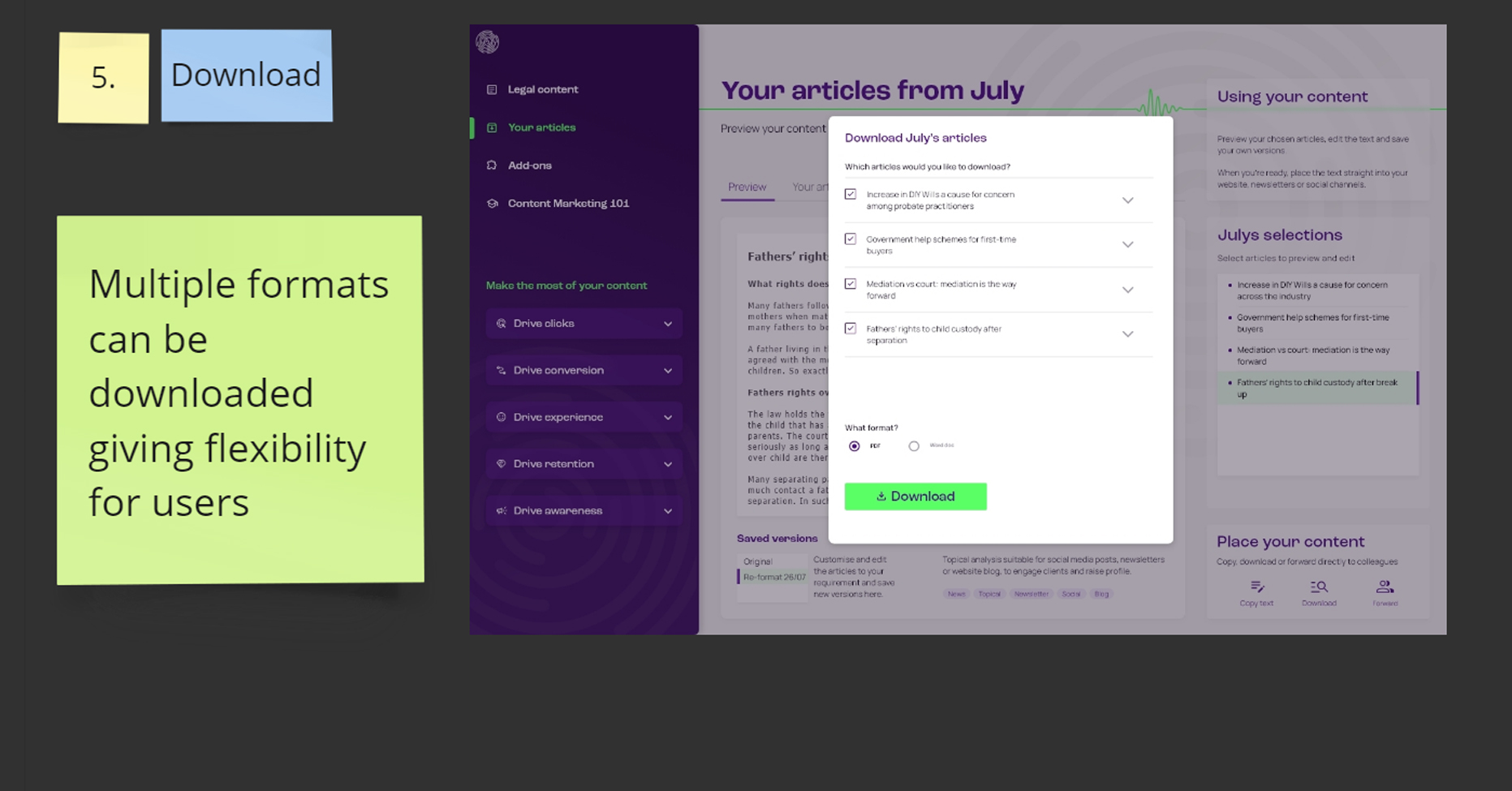B2B subscription site
Today’s Media is a legal publishing company providing specialist pre-written content for legal practitioners to use in their marketing channels.
The content was originally delivered manually via email, with a time-consuming and convoluted process.
During the design of their brochure site, I proposed the idea of automating the delivery via an online platform, giving clear improvements to experience and efficiency.
Following the end-to-end design process I devised the concept for a subscription website to deliver the monthly articles, with a landing page to drive sign-ups.

Design process
- Research & discovery to align functionality & content with user goals, business objectives, and technical constraints.
- Design & iteration of wireframes and user flows for registration and monthly delivery of content.
- Brand concept for visual design and UI style guide.
- Design of all written content including landing page sales copy and dashboard UX copy.
- High-fidelity prototype
- User testing
The big idea…
The target audience within the legal sector are often small firms that carry out their own marketing activity.
DIY marketing tips are therefore useful, and simple guidance is readily appreciated and in demand.
With this in mind, the design includes content to educate these DIY marketeer, helping them to use their content smarter, and grow their business.
This adds significant value to the product, and gives a framework to the categorisation of the archive so users can search for content based on their end goals.

Goal led design
Discovery
- Stakeholder interviews to identify business objectives and establish technical requirements
- Existing data & personas
- Competitor analysis to learn about legal sector and product space
- User interviews to understand the context of law firms using the content, and establish their overall goals
- Survey to large Today’s Media database to explore content marketing within the legal sector
Customer feedback
User interviews were not readily available at the beginning of the project, so webinar feedback and comments from clients to sales representatives provided a valuable alternative for insights.
“Your webinar is really interesting, looking forward to the next”
“Over half of the webinar comments were requesting samples”

Competitor review
Four competitors were compared to gain an understanding of the product space – two direct competitors, one in the property market and a larger, general content site.
Key findings
The benefits of written content were difficult to establish, deep into the site and buried in heavy text and riddles. They should be clearly spelled out in plain language on the landing page.
The CTA was filling in a form or sending an email to request samples, which seems like a significant barrier. Constant Content however, have a slick and easy registration process.
Click the logos to read the full write-ups.
User insights
Profile
Small to medium sized law firms who carry out their own marketing activity to grow their business.
They understand the value of marketing, but they may not have knowledge of the different ways in which content can be used.
DIY marketing tips are therefore useful, and simple guidance is readily appreciated and in demand.
Context of use
Busy law firms with multiple departments liaising to choose articles each month, often with no dedicated marketing manager to oversee this process.
Emails are sent back and forth between solicitors to preview content each month, and make final decisions.
How it is used
Website service pages
Blog
Client guides
Social media
Newsletters
More details…
User interviews
Two interviews were carried out with two different types of client. Its great hearing the end users describe the benefits of the product and how they use it, compared to competitor website copy promoting the content. They describe it in plainer, more understandable terms. No riddles, just their goals, and how they use it. Simple.
Baker Law is a large, full-service law firm with several departments making use of the content. Interview objectives included exploring how the content would be delivered, and finding out exactly how they currently access, choose, and distribute the content between departments so the new platform could be designed to deliver the articles as seamlessly as possible.
Marcus Bishop Associates is an Independent Financial Advisors who are certified to carry out work typically done by Wills & Probate solicitors. It was important to interview different types of client, who may have different goals, objectives, and operations. Great example of a small, independent firm doing DIY marketing, and using the content to do this.
Webinar feedback
If you followed every bit of advice from the big UX blogs, you would apparently need to carry out a minimum of 372 user interviews just to be sure you have accurate data. As I have found in practice, this is not always possible for various different reasons. Today’s Media ran a popular monthly Content Marketing webinar giving tips to lawyers, and feedback from attendees provided valuable insights to back up the interviews.
5 objectives of content marketing
Via the endless trawling of product descriptions and benefits across several competitor websites, along with the stakeholder and user interviews, the ultimate goals of using ready-made content were established.
Here is the entire field of content marketing summarised in five sentences:
- Valuable content to attract prospects.
- Build credibility to increase conversion.
- Client support to improve service.
- Engage to maintain relationships.
- Brand awareness to get the name out there.
Pretty much every possible strategic objective and goal of content marketing can be categorised into one of these five bullet points.
SEO is not included because it is syndicated content with duplicates on other sites, so search engines do not display the content.
These five objectives formed the basis of the benefits on the landing page, and provided the framework by which the content was categorised, effectively enabling users to search for articles by goal.
Goal led design.
Business requirements
- The purpose of the platform is to save time delivering the articles manually each month.
- New users should be able to subscribe and set up their account from the landing page.
- They want a searchable archive, but also to maintain the addition of 25 new articles each month, across 5 areas of law.
- Packages are dependent on the number of articles.
- Subscribers should be able to log in, select and download their monthly quota of content.
- Automated notification emails should be sent out each month when the new articles are uploaded onto the site.
Click sitemap to enlarge
UI
Brand concept
The designers concept for the Today’s Media logo was based on their status a news publication, with their ‘finger on the pulse’.
I continued that theme with a ‘pulse’ of electricity representing the content that powers marketing activity, and drives the growth of your business.
Colour palette
Corporate legal firms often use a safe & serious blue. I wanted a less formal, more creative feel, so deep purple is a good fit.
The accent is a bright and saturated green on the opposite side of the wheel, which represents the pulse of power and the content. This only works in small areas so there is another, less saturated green tone for larger CTA buttons.
A lighter tone of purple on the content archive is used for any elements that a relate to the categorisation of the articles.
Typography
Display font: Roc Grotesque / Adobe fonts.
Body font: Manrope / Google
Roc Grotesque is an informal sans-serif matching the creative tone. Manrope is a nice, clear body font with lots of styles for hierarchy.
Flows
- Landing page
- Registration
- Choose articles
- Search for articles using filters
- preview, edit & download
- Browse article history, re-purpose
- Forward to colleagues
- Monthly delivery – considering context of law firms – busy colleagues liaising and choosing
Landing page
Primary objective
Conversion / sign-up / subscriptions / new customers.
Explain the benefits in plain terms, make it easy to sign up.
Secondary objective
Sales funnel / content strategy / useful content / data capture
More details
Clear benefits
Finding the clear benefits on competitor websites was very hard. The ultimate goal for the end-user is to grow their business, and written content can be used in different ways to achieve that. So it makes sense to explain these different ways in clear terms, using language that lawyers and small business owners understand.
I want them to understand very quickly, exactly what the content can do for them and how it does it.
Explaining the five pillars of content marketing on the landing page both summarises all the benefits, and introduces clients to the five objectives by which they can search for content with the filters.
The free tier
Competitors all require users to request samples via email or telephone call, which seems like a significant barrier.
Over 50% of webinar comments were requesting samples.
The CTA/registration took these points into consideration – rather than filling in a contact form to request samples, prospective customers can sign up to a ‘Free tier’ with a quick and easy registration process.
Once signed-up they can browse the full archive to see all the topics and subjects available. With the free tier, they can download three sample articles to use. After the three have been downloaded, they can only access more by upgrading to a paid tier.
This means:
- They can easily see the samples and browse the archive.
- There is a structural bond with them so further marketing/sales funnel activity can encourage them upgrade to a paid tier.
Subscribe flow
Objective
Quick and easy sign-up.
Option to add colleagues so multiple departments can login, select articles, and use content.
More details
This flow is for a paid tier. The free tier requires a different flow without the payment details page.
I aimed to keep the number of fields as low as possible to increase completed sign-ups. It may be that Today’s Media would also like some more information about the firm, i.e. what kind of firm they are, how big, and what areas of law they cover. This would increase the number of clicks to subscribe but the information may be useful for future insights.
Validation rules not shown here.
Registration flow clip
Article selection flow
Objective
Preview the latest added articles – 25 added each month as per brief.
User lands on page with latest new articles, and can navigate to the full archive in top menu.
User browses content and makes choices for each month, adding articles until monthly package quota met.
Article selection clip
Using the filters to search the full archive
The big idea – DIY marketeers
The design aims to support DIY marketeers, helping educate them about different content marketing objectives, and allowing them to search for articles that can be used for those objectives – goal led design.
This flow demonstrates the sidebar tips and search filters that support this concept
Use-case example
A law firm has recently received a number of website enquires from fathers about child custody following divorce, but found that none of them were converting. They want to find useful articles around this topic for their website, that explain more about parents rights. This may encourage these website visitors to hire their services.
Preview and edit articles
Once the content quota for each month has been chosen, users can preview and edit the articles, and save their own new versions.
Browse article history and re-purpose
Subscribers can access all of their previously downloaded articles.
Lawyers can re-purpose and re-use old articles to maximise value. Typically, these would be MS Word docs stored in a folder somewhere. The design enables them to easily re-access their article history, and save new versions to re-purpose.
An example described in the user interview used an article about child contact over the Christmas holidays, and re-used it for the summer holidays.
This flow shows how to find the article, load it up into the preview page, make changes and save as new version.
Forward articles to colleagues
With no dedicated marketing manager to oversee the process, being able to forward articles to colleagues makes the process of distributing the content easier.
Monthly content delivery
A key objective of the design was devising a monthly delivery process that fits in with the day-to-day operations of busy law firms, with no dedicated marketing manager to oversee the article selection between departments. Research and solution via automated emails outlined below.






















